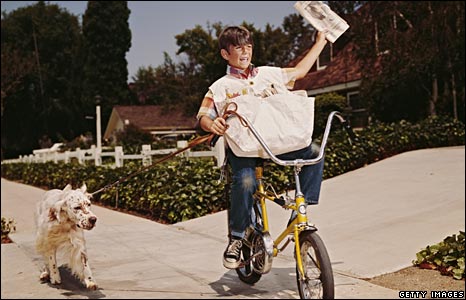Entries in We Energies (16)
9/1/10 Sow the wind turbine, reap the crop damage AND...Wind Action Asks the hard Question: How compatible are wind farms and agriculture? AND Wind Turbines in the News AND A new understanding about wind turbine noise AND A letter from a participating wind project landowner from Columbia County to landowners in Brown County
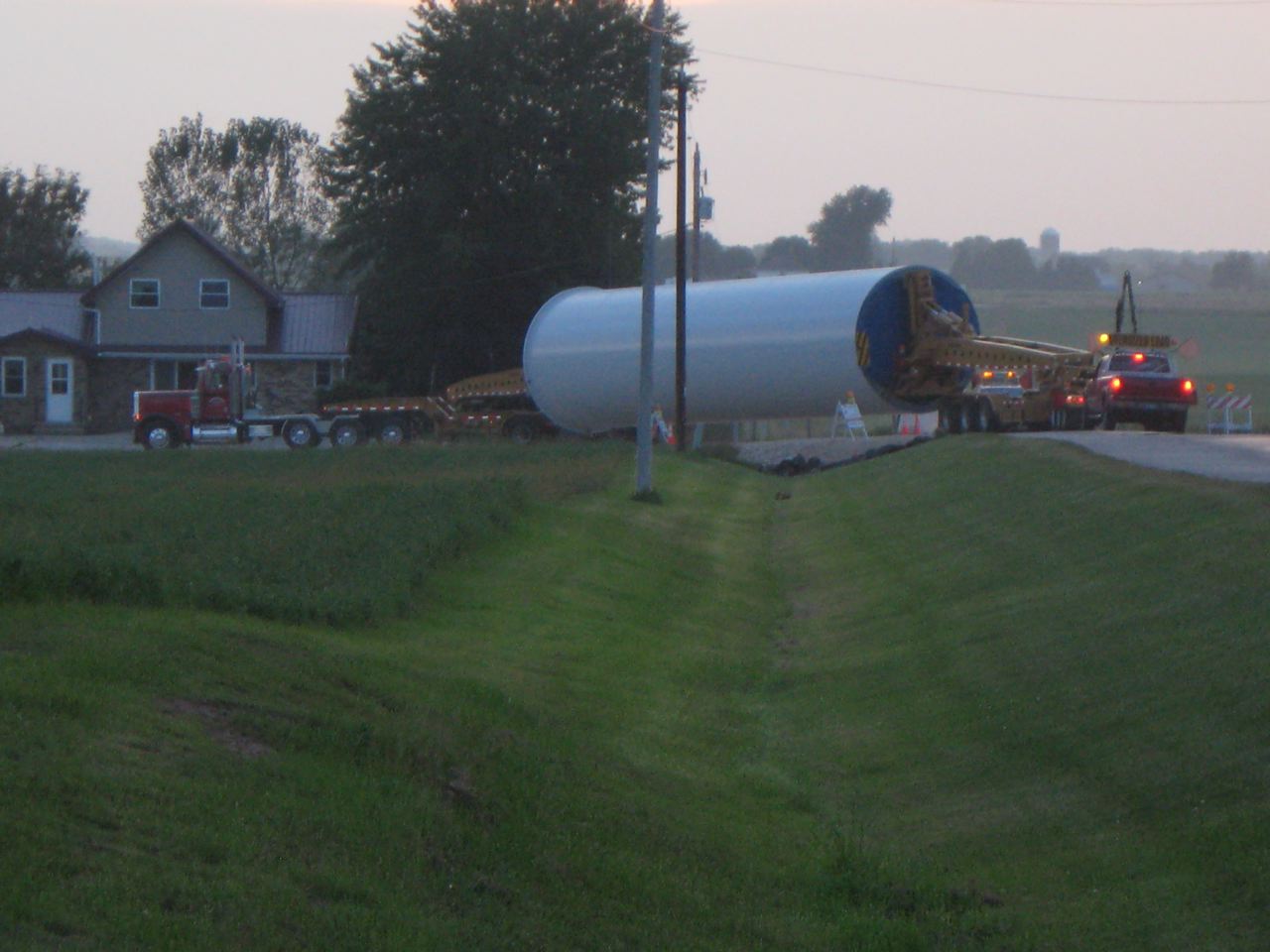
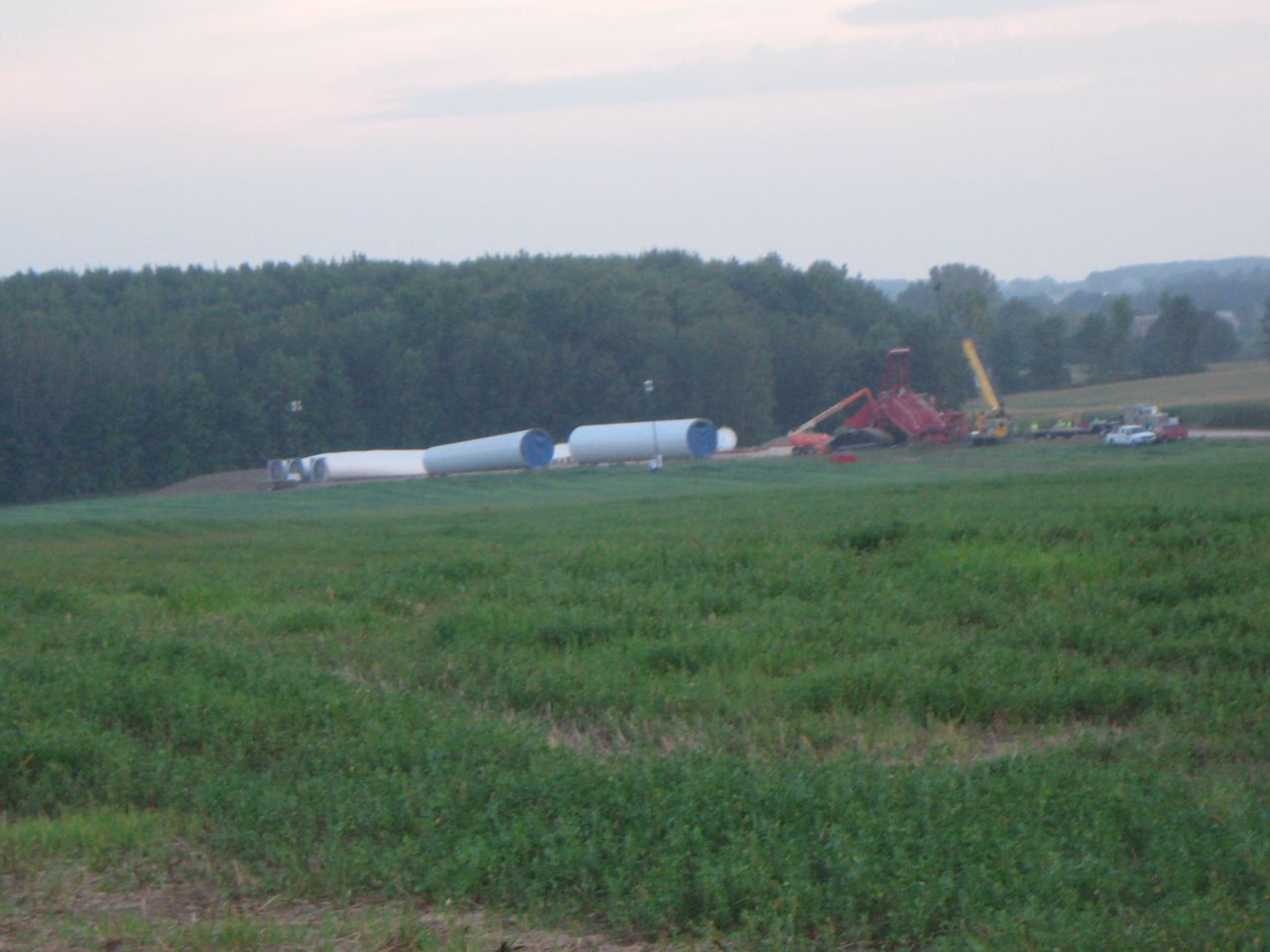 Construction begins on what will be the tallest wind turbines in the state. Town of Glenmore, Brown County Wisconsin. More photos throughout this post.
Construction begins on what will be the tallest wind turbines in the state. Town of Glenmore, Brown County Wisconsin. More photos throughout this post.
Below is A letter from a participating landowner in the Glacier Hills project which is under construction in Columbia County. He address it to Brown County landowners in an area where Invenergy wants to site a large project called "Ledge Wind"
SOURCE: PSC Docket # 9554-CE-100
To the landowners in the Ledge Wind Project:
If you believe wind turbines are a good fit for a farm operation, a free source of clean energy, and a benefit to your community, I invite you to come to the Glacier Hills Project and witness the total devastation occuring during construction.
Seeing firsthand what is happening here would turn any responsible landowner's stomach.
Heavy rains have created erosion that will take years to repair.
The number of huge construction equipment and trucks burning fuel is staggering.
Good productive farmland is being ripped apart, and will never be the same.
The level of disgust is even affecting the most loyal supporters of this project.
Hatred of this project is growing worse as each day passes, and we will be forced to live with this for the rest of our lives, all because a few irresponsible landowners, myself included, were taken in by wind developers lies.
All this for chump change.
Gary Steinich
Cambria, Wisconsin
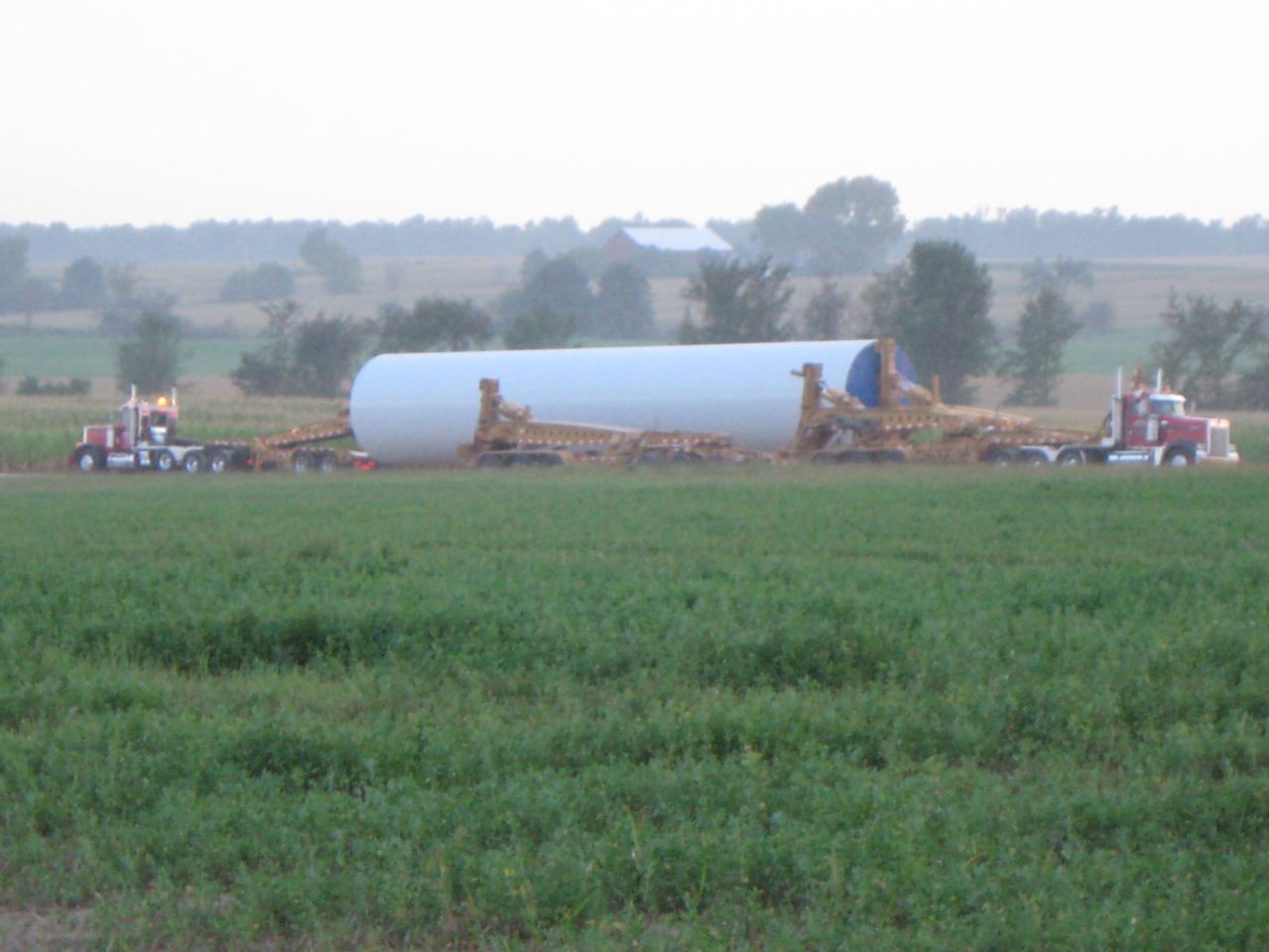
Is wind "farming" compatible with agriculture?
August 25, 2010
We're frequently reminded that wind energy and agriculture are compatible land uses. Farmers who lease sections of their crop land for wind development can continue working the soil right up to the towers and earn extra revenue for farming expenses. A win-win business opportunity, right? Not so fast. In this two-part series, Windaction.org examines the wind-farming relationship in the State of Illinois and tests the claim that the two are a good fit. As with so many topics involving wind energy, there is another story behind the story.
Back in 2007, Windaction.org posted a document entitled "What have I done?" The piece, written by Don Bangart of Chilton, Wisconsin, was based on a two- hour interview he conducted with a farmer in Northeast Fond du Lac County who agreed to lease a portion of his land for wind development. In the interview, the landowner makes several observations including this about how his land was managed:
"I watched stakes being driven in the fields and men using GPS monitors to place markers here and there. When the cats and graders started tearing 22 foot wide roads into my fields, the physical changes started to impact not only me and my family, but unfortunately, my dear friends and neighbors. Later, a 4 foot deep by 2 foot wide trench started diagonally across my field.
"A field already divided by their road was now being divided again by the cables running to a substation. It was now making one large field into 4 smaller, irregularly shaped plots. ...We soon realized that the company places roads and trenches where they will benefit the company most, not the land owner. ... All of the rocks we labored so hard to pick in our youth were replaced in a few hours by miles of roads packed hard with 10 inches of large breaker rock. Costly tiling we installed to improve drainage had now been cut into pieces by company trenching machines."
The Wisconsin farmer's experience is not unique.
Illinois has some of the best farming soil in the world with McLean County, Illinois rated #1 for the darkest, blackest most productive soil in the world.
But after extensive land moving and excavation needed to build roads and erect the turbines, farmers tell Windaction.org that the ground is never the same afterward. The fertile soil around the towers is mixed with subsurface clay and compacted resulting in lower crop yields. Depending on the lease terms, developers may compensate landowners for crop reductions but payments are often not passed on to tenant farmers who suffer the actual losses.
Since compaction is assumed to be a construction-related impact, crop-loss payments are often time-limited up to five years. However, every time turbines require maintenance, the massive crane is brought back to the site making compaction an ongoing concern throughout the life of the project. And it's not limited to existing roads or turbine pads. Turbine maintenance crews prefer to crawl across fields -- flattening crops and ground -- for quicker access to turbines needing service.
If drainage tiles are cut or damaged during construction, you're apt to see farmers working around ponds that were previously nonexistent. Or worse, adjacent fields not under lease can flood. With competition for rentable farmland so fierce, local tenant farmers risk losing their farms if they complain.
Soil compaction and drainage issues are serious concerns, but some might argue their effects are localized, and thus manageable. But that cannot be said about the impact of wind turbines on aerial spraying -- a subject that gets very little exposure.
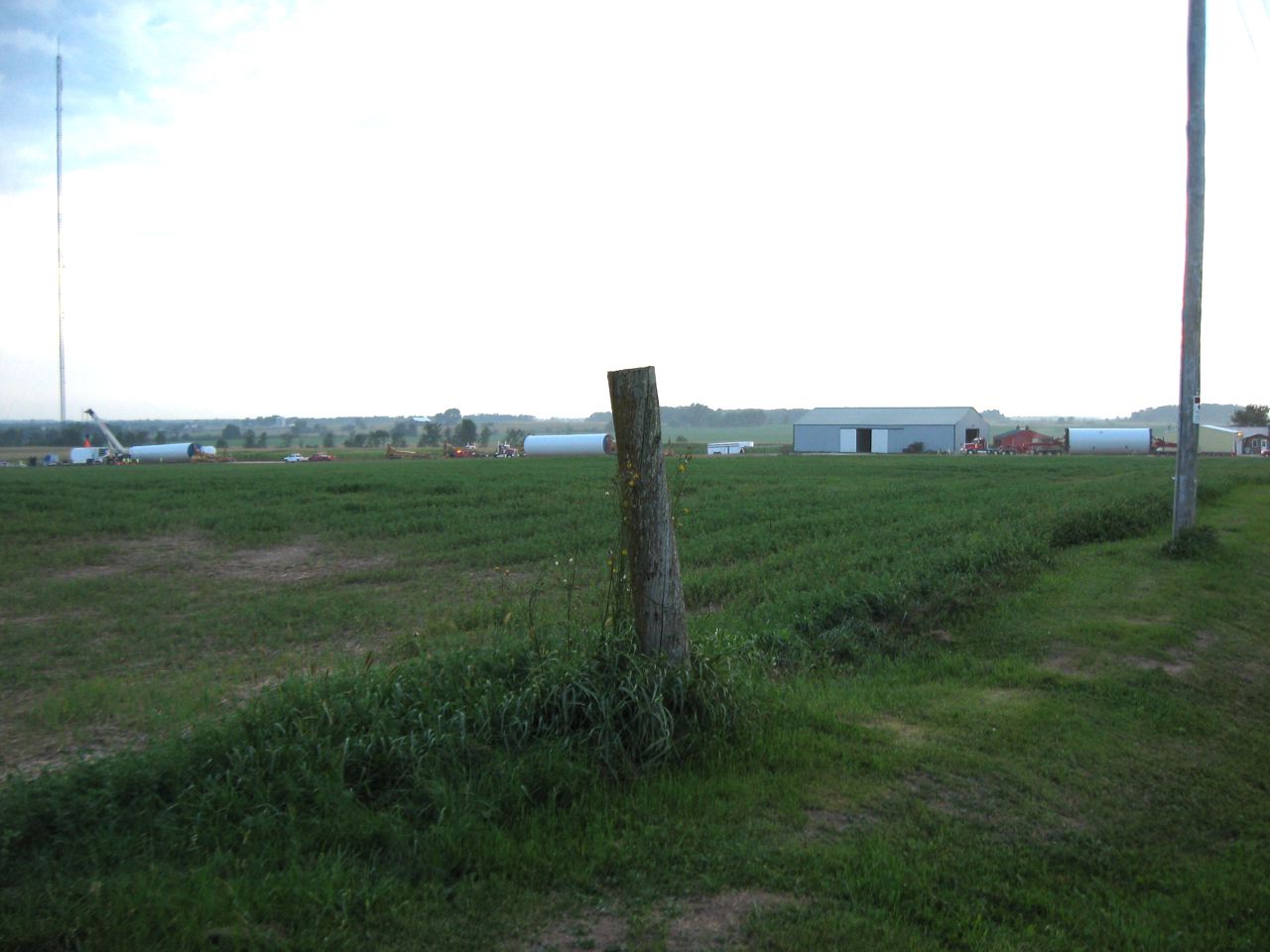
The ability to secure aerial spraying services is limited in areas where turbines are standing.
The message on the Illinois Agricultural Aviation Association (IAAA) website is clear:
"...farmers with wind generators may lose the option of aerial application of farm protection products, seed, fertilizers, etc. on their farm ground. Possibly more significant is that their neighbor farmers, who have no wind generator(s) and consequently no income from them, stand to lose that option as well.
"Some proponents of wind farms tend to dismiss this possibility out of hand, with the explanation that "those guys can fly around them with no problem," or "just get a helicopter to do it." Others say that ground application can still be effectively performed so the aerial option is insignificant. Unfortunately, it is just not that simple. Sometimes weather problems and/or timeliness of application dictate an application from the air.
"The fact is, it is dangerous to fly within the confines of a wind generator farm."
As more and more towers go up, less and less fields can be sprayed. Experienced pilots can feel the wake effect of the towers from several miles away. Such turbulence is dangerous to fly through.
Helicopters may be recommended because they travel at slower speeds and can work in more confined spaces but they can't carry the same loads meaning more trips at higher costs. There are far fewer helicopters in the State (under 10 in total) so timely availability is a critical issue.
Some farmers try ground applicators but aircraft can cover crops faster and more efficiently than any ground rig. In cases of Asian soybean rust, farmers could experience an 80-100% yield loss if not treated within a week. Aphids or spiders mites can destroy a field within days. If infestations occur during wet years ground equipment on wet soil will cause compaction or ruts that lead to erosion.
Illinois County Boards tasked with approving new wind development appear willing to accept that aerial applications are still possible but with more difficulty and at a higher cost (most spray policies charge premiums up to 50% above standard costs on fields within a mile of the towers, whether a participating landowner or not). What they do not seem to realize is that as more wind farms are permitted, the cumulative effect will lead to fewer and fewer fields that can be sprayed, making total crop loss a real possibility.
Since crop insurance will not cover the farmer in cases of insects or plant disease where damage is "due to insufficient or improper application of pest control measures or disease control measures", crop loss could lead to significant financial losses for farmers.
Illinois farm land has nearly 1900 megawatts of wind turbines installed across thousands of acres of farm land and thousands more slated for development. Absentee landowners may be gaining financially from the development, but the idea that "wind farming" is a compatible agriculture use is more myth than reality in Illinois.
Special thanks to Rick Reed, president of IAAA, who provided valuable information on aerial spraying.
Wind Turbines in the News
For the latest national and international wind news visit
News
GREEN PARTY OF CANADA CALLS FOR WIND TURBINE HEALTH STUDY:
Source: Green Party of Canada Website
Considerations:This motion, in calling for a study on the human health effects of wind turbines, would create a new policy and could potentially call into question some of the party's policies on significantly increasing the amount of energy produced through wind turbines.
Motion Preamble:WHEREAS the Green Party of Canada recognizes the vast potential for wind energy in Canada;
WHEREAS the Green Party of Canada with the Canadian Wind Energy Association has set goals for Canadian wind energy generation;
WHEREAS many citizens in communities with wind turbines claim to be experiencing sleep deprivation, headaches, and heart complications related to wind turbines;
WHEREAS one of the largest obstacles preventing accelerated wind energy development is resistance from citizens near planned turbine sites;
WHEREAS the largest investment Canadians make, their home, is affected as much by real health risks as perceived ones;
WHEREAS many provincial governments have compromised their objectivity with respect to wind energy development;
WHEREAS the Green Party of Canada considers healthy people and healthy communities as necessary for a strong Canada;
Motion Operative:THEREFORE BE IT RESOLVED that the Green Party of Canada seeks to have Health Canada initiate an epidemiological study on the human health effects of wind turbines in the interests of public health and safety.
Dong giving up on land-based turbines
Mass protests mean the
energy firm will look offshore
SOURCE: The Copenhagen Post Online
September 1, 2010
State-owned energy firm Dong Energy has given up building more wind farms on Danish land, following protests from residents complaining about the noise the turbines make.
It had been Dong and the government’s plan that 500 large turbines be built on land over the coming 10 years, as part of a large-scale national energy plan. This plan has hit a serious stumbling block, though, due to many protests, and the firm has now given up building any more wind farms on land.
SOURCE, ” On the Level: Quarterly Newsletter of the Vestibular Disorders Association (Summer 2010, p. 9)“Wind Turbines Can Affect Inner Ear Function,
Scientists have determined how infrasound from wind turbines may influence inner ear function.
An increasing number of people living near wind turbines report a group of symptoms termed “wind turbine syndrome” that include sleeplessness, dizziness, fatigue, ear pain and pressure, difficulty concentrating, and headache.
Up until now, many scientists who study hearing claimed that noise from wind turbines couldn’t be harmful because it occurred at a frequency too low for most people to hear.
Researchers at Washington University in St. Louis, Missouri successfully challenged this conventional wisdom that “what you can’t hear won’t hurt you.” They noted that one type of inner-ear sensory cell behaves differently when encountering infrasound.
Usually these cells respond to sound by contracting and expanding proteins within their walls, amplifying vibrations, which in turn stimulate other sensory cells to send electrical signals about sound to the brain. However, the proteins do not respond in the same way to infrasound and instead actively prevent stimulation of the cells that transmit sound signals.
So, while the brain may not receive information about sound, a physiological response to infrasound has occurred in both the cochlea and the other sensory structures in the inner ear such as the saccule, possibly explaining the unfamiliar sensations experienced by some people.
Reference:
Salt AN, Huller TE. “Responses of the ear to low frequency sounds, infrasound and wind turbines.” CLICK HERE TO DOWNLOAD Hearing Research 2010 Sep 1;268(1-2):12-21. Epub 2010 Jun 16.
8/27/10 What's it like to live in a Wisconsin Wind Project?
This interview was conducted by Tim Harmann who is with the Brown County Citizens for Responsible Wind Energy (Link: BCCRWE.com)
Elizabeth Eberts is a resident of the We Energies Blue Sky/Green Field wind project. Click on the image below to hear what she has to say about living with wind turbines. For those whose internet connection isn't fast enough to watch video, a transcript is provided below.
Transcript of Interview with Elizabeth Eberts
I'm a non participant of the wind turbines but I have them to the north, west and south of me. We live down in this hollow part and they just come straight above by our house and we hear all the noise.
And sleeping at night, if they don't turn at night, I sleep great. Like last night I had a terrific nights sleep but this week, Wednesday they were really going and just like that in the middle of the night I'll just jump up and there's nothing I can do.
It just does something. I don't know what the noise is that wakes me up or what it is but I can sleep through thunderstorms, anything. But I cannot sleep through this. I've tried different things but I just can't.
And I complained to them about the noise and they said they can do nothing about the noise. It's the way it is, etc. etc.
Well I had my son over here because he had to have major surgery. And you know, because we could leave from here I thought it was real nice.
Well then he told me, he said he couldn't sleep all night because it sounded like an airplane hovering over his bedroom all night long. So he couldn't sleep.
And I thought it was just me, you know? I never gave it a thought.
In our township, noise means nothing. That's exactly what they told me. They say it at every meeting you go to. "We're not going to discuss the noise."
Well, it's a big problem here. Especially for me with [turbine noise ] coming down at me.
And they just don't acknowledge it at all.
So in addition to your noise and your sleep, you had some problems with your TV?
Well we have problems with the TV, the scanner and the FM radio.
The TV was the worst of them all. It took a good year, and I just told them after all that they did I said that this is it. Take it out. I don't care what you give me. I can't stand it any more.
It would go out. You'd be listening to a program, you'd see half of it, and all of a sudden it's gone. Then it would come back again. Well. It was just totally out of control. I was just plain frustrated. You just turned the TV off and just let it off for awhile.
And you said you visit your daughter who is in the wind farm too and she has other issues?
Yes. She has bad shadow flicker. Over the complete house. Because the wind turbine to the east of her is on a very high hill, so it covers their whole house.
She can't go anyplace in her house where she does not see shadow flicker.
Well, [the wind developer] offered the blinds and that. Well, [the flicker will] go through the top part of your window. You can put them up as good as you want, it still goes through.
I was putting up-- we made curtains for her--- and I was putting them up and I seen this flickering going in there, and I said, "Oh my gosh," I had to get down from the ladder and turn away from it.
And she says, "Oh, this isn't bad, mom."
Well, to me it was. That was very bad.
But they will put blinds up for you or whatever
But what do you put windows in your house for?
[This wind farm] they just put it up and that was it. They didn't work with us at all.
And what they say to you, don't believe them.
I had this guy from We Energies coming into my house and telling me he'd give me back everything he took away.
And then he shook my hand.
And you know what? To this day yet I haven't gotten everything back they took away, They can't give me it back. There is no way. Unless they stop these turbines.
8/4/10 DOUBLE FEATURE Wind developer to local government: Law is on my side. In fact, I'm writing the law AND The noise heard 'round the world: report finds negative health impacts from wind turbines
PERMITS EXTENDED ON WIND FARM
August 3, 2010
By Lyn Jerde
Another Columbia County wind farm - this one in the county's southern tier - is still up in the air.
The Columbia County Board's planning and zoning committee Tuesday extended, by one year, conditional use permits to two landowners, which would allow for another year of testing wind speeds, using two 197-foot test towers set up by the Madison-based Wind Capital Group. The towers have been in place for two years.
One of the towers is in the town of Arlington, on land owned by Sherri and Lloyd Manthe. The other is in the town of Leeds, where the landowner hosting it is Alan Kaltenberg, a town supervisor.
Planning and Zoning Director John Bluemke said the extension of the conditional use permit to Aug. 1, 2011, as approved by the committee, is contingent on approval from the Arlington and Leeds town boards.
Thomas Green, senior manager for project development for Wind Capital Group, said results from the test towers (which don't have bladed turbines, as electricity-generating windmills do) have shown that southern Columbia County could have wind that is strong enough, and frequent enough, to make the area a viable location for a wind farm.
But discussion is still in the early stages, he said.
"Thus far, we feel pretty good about the wind capacity in the area," he said. "We know we have to have the data to take further steps."
Another year of testing the wind would provide additional information while the Wind Capital Group assesses other factors that might determine whether their wind farm might be in Columbia County's future.
In northeast Columbia County, construction has begun on the access roads and headquarters for the Glacier Hills Energy Park, being built by We Energies, in the towns of Scott and Randolph. The Glacier Hills turbines are scheduled to be built in the summer of 2011 - up to 90 of them, each about 400 feet from the base to the top of the highest blade tip.
If Wind Capital Group builds a wind farm, Green said, it would sell any power generated to an electric utility.
In speaking to the planning and zoning committee Tuesday, Green noted that there currently are state and federal initiatives to encourage the construction of facilities that generate electricity from renewable resources such as wind.
"For the foreseeable future," added committee member Fred Teitgen.
Green said he doesn't see the incentives going away any time soon, partly because Wisconsin has a law requiring utilities to generate a percentage of their electricity from renewable resources.
Committee member Harlan Baumgartner said he's not convinced that wind will be or should be a major factor in future energy generation.
"There might be other ways of producing energy that are more feasible than wind," he said.
Although officials of the towns of Leeds and Arlington must sign off on the extension of the test towers' conditional use permit, neither the towns nor the county can, legally, make their own regulations regarding the siting of wind turbines.
It's not that the town of Arlington hasn't tried. In the spring of 2009, the town board adopted an ordinance requiring that all wind turbines must be at least 2,640 feet, or half a mile, from buildings.
However, a new state law has directed the Public Service Commission of Wisconsin, which regulates the state's utilities, to set parameters for wind turbine siting that would be applicable throughout the state - meaning that no county, town, village or city could make rules that are more restrictive.
Green said the PSC is in the process of drafting those rules, and they should be in place soon.
"We can't make a decision," he said, "until there are standards in place."
NOTE FROM THE BPWI RESEARCH NERD:
One thing this article does not mention is that Tom Green himself is writing the 'standards' that will allow him to site this project.
When the state legislature voted to strip local government its power to regulate wind projects, Tom Green of Wind Capitol Group was appointed to the 15 member Wind Siting Council which has just finished writing siting guidelines for the entire state.
Like Tom Green, the majority of the council has a direct or indirect financial interest in creating rules that favor wind development over protection of local residents and wildlife.
SECOND FEATURE
What's the "Dean Report" and why does it matter to wind project residents? Here's what windaction.org has to say about it
The Dean Report
Acciona Energy's Waubra wind farm, located in western Victoria, Australia is the largest operating wind facility in the southern hemisphere.
Within weeks of the towers first being turned on, Noel Dean began suffering adverse health effects. Australian newspapers quoted Dean this way: "I was waking up two days in a row with headaches, I'd have to take Panadol but they'd be gone by dinner time.
When the wind is blowing north I got a thumping headache, like someone belted me over the head with a plank of wood and I didn't know whether to go to the hospital or what to do. You couldn't really work."
Other symptoms he and his wife experienced included general malaise, nausea, sleeplessness and general uneasiness.
By July, the Deans had packed up and left their farm.
Around the same time, an investigation of wind farm noise complaints was underway in New Zealand.
Residents living near the towers in New Zealand were filing complaints of sleep disturbance, annoyance, anxiety and nausea. As more people in both Australia and New Zealand became comfortable in talking about their health concerns a picture began to emerge that researchers found unusual.
There were compelling similarities between experiences in two totally different countries, totally different environments and totally different turbines.
Audible wind farm sound and consequential sleep disturbance, annoyance and anxiety responses were similar for people in both countries. These effects were also experienced even under situations of near inaudible wind turbine sound.
The concerns of the Deans and others living within 3500 meters of operational wind farms triggered more than twelve months of intensive study by a group of 4 qualified researchers.
The result is The Dean Report, a detailed peer-reviewed analysis of the sound levels near the Dean's properties and the potential adverse effects of wind farm activity on human health.
Dr. Robert Thorne PhD[1], who authored the report, based his findings and conclusions on extensive field work, personal investigations, case studies and the development of sound analysis methodologies. He told Windaction.org that "the Dean Report, in its various forms, has been placed in evidence subject to cross-examination before a Board of Inquiry and formal wind farm hearings for the purposes of peer-review and critique. A hypothesis as to cause and effect for adverse health effects from wind farm activity is presented."
In news reports today, wind farm operator, Acciona Energy, insisted "there is already enough existing credible evidence proving there are no health effects from wind farm noise."
We respectfully disagree. The Dean Report makes clear we are only just beginning to understand problem.
[1] Dr. Thorne is a principal of Noise Measurement Services Pty Ltd in Australia. He holds a PhD in Health Science from Massey University, New Zealand. His professional background is the measurement of low background sound levels and the assessment of noise as it affects people.
Windaction.org wishes to express its thanks to Dr. Thorne and Mr. Dean for sharing the Dean Report with us and permitting us to provide its content to our readers.
Excerpt from the Dean Report:
Further research has shown that the acoustic energy from wind
turbines is capable of resonating houses, effectively turning them into
three-dimensional loud speakers in which the affected residents are now
expected to live.
The phenomenon of natural resonance combines to produce a cocktail of
annoying sounds which not only disturb the peace and tranquility
once-enjoyed by the residents, but also stimulate a number of disturbing
physiological effects which manifest in the physical symptoms described
above.
In the opinion of the author, backed up by residents' surveys and scientific
measurements and analysis of the noise of turbine can be a significant
detractor for those living within 10 kilometres of them.
More research is urgently needed to determine the extent of the nuisance
effects and what setbacks are required to minimise the negative effects on
resident communities.
The long term medical implications are considerable and need to be
researched before any further applications for wind farms are consented.
Failure to do this, in the opinion of the author, will significantly effect
the utilization of this technology and will produce long-term consequences
that will be to the detriment of the whole of society.
Notes:
[1] The Waubra wind energy facility is located near Ballarat, in western
Victoria, Australia. It is the largest operating wind facility in the
southern hemisphere consisting of 128-1.5 megawatt turbines for a total
installed capacity of 192 megawatts. The turbines were first turned on in
February 2009; the facility was fully operational by July 2009.
[2] Noel Dean and his family moved away from their farm in the spring of
2009 when the headaches and other symptoms worsened
7/26/10 TRIPLE FEATURE: From open arms to balled up fists: Wisconsin resident comments on living in a wind project under construction AND Why he left the family farm: Wisconsin resident lays out his first-hand experience with wind development. The majority of the Wind Siting Council looks the other way
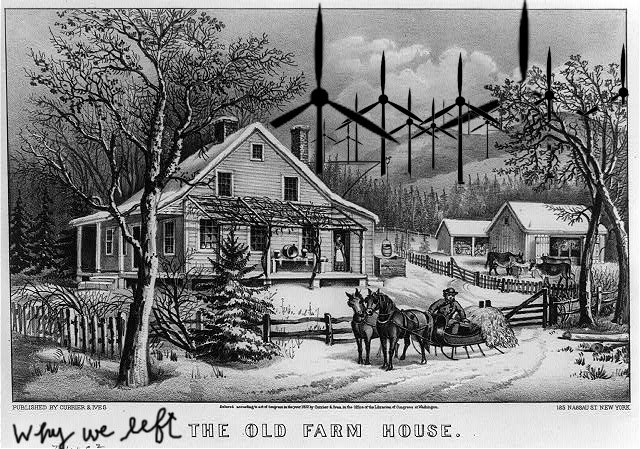
PUBLIC COMMENT TO PUBLIC SERVICE COMMISSION FROM RESIDENT OF PSC APPROVED GLACIER HILLS PROJECT CURRENTLY UNDER CONSTRUCTION:
To the landowners in the Ledge Wind Project:
If you believe wind turbines are a good fit for a farm operation, a free source of clean energy, and a benefit to your community, I invite you to come to the Glacier Hills Project and witness the total devastation occuring during construction.
Seeing firsthand what is happening here would turn any responsible landowner's stomach.
Heavy rains have created erosion that will take years to repair.
The number of huge construction equipment and trucks burning fuel is staggering.
Good productive farmland is being ripped apart, and will never be the same.
The level of disgust is even affecting the most loyal supporters of this project.
Hatred of this project is growing worse as each day passes, and we will be forced to live with this for the rest of our lives, all because a few irresponsible landowners, myself included, were taken in by wind developers lies.
All this for chump change.
I affirm that these comments are true and correct to the best of my knowledge and belief.
Gary Steinich
Cambria, WI
SECOND FEATURE
TESTIMONY
Comments submitted by Wisconsin resident, Joe Yunk, to the Public Service Commission of Wisconsin, July 2010
My name is Joe Yunk; I currently reside at the address of N2630 Townhall Rd in Kewaunee County.
My prior address was North 7905 County Trunk P, Algoma, Wisconsin which was in the Wisconsin Public Service (WPS) wind farm by Rio Creek, Wisconsin. I moved from the Algoma address to my current address on or about October 2009 to get away from the effects of the WPS wind farm.
I have been following the current proposed Element Power LLC (EEP) wind farm development that I now find myself living in.
I want you to know what I went through while living in the WPS wind farm. I am hopeful that this information will help you make the right decisions with regard to any PSCW approvals for any other wind farms in Wisconsin.
I would hate to see other peoples’ lives to be as negatively affected as mine has been as a result of living in a wind farm. There is no doubt in my mind that I will relive the awful experience once again if the EEP wind farm for Kewaunee County is approved.
In 1998 the WPS wind farm construction began about 300 yards from my home. I had built this home in 1980 on 6.5 acres of land which was our home farm that I lived on all my life. I was born on November 28, 1954. I had two turbines within one-half mile, one of those turbines was about 1,300 ft from my house and 600 ft from my property line.
In the summer of 2000, the turbines of the WPS wind farm began operation. Inasmuch as I had lived on this farm all my life, I knew the neighbors well, and it wasn’t long after the turbines began operating our lives began to change.
In conversations with my neighbors, I learned, they too were experiencing constant disturbing noise, shadow flicker and just the constant presence of the turbines. By presence I felt uneasy and irritated by the size and closeness of these 220 ft. turbines.
All the people living in this wind farm were guinea pigs/lab rats, no one knew what we were in for. It was in the fall of 2000 when neighbors and families began to divide over the effects of the wind farm. And that continued throughout the time I lived there.
When the turbines began to operate, a hotline was established directly to WPS to report any problems.
I had beef cattle for about two years prior to the turbines operating and never lost any animals. However, shortly after the turbines began to operate, I had beef cattle become ill and die. I reported this on the WPS hotline and nothing was done. I lost ten animals valued at $5,000 [each] over a two year period and couldn’t afford to continue.
Because of noise complaints to WPS, within a year, two families’ homes were purchased by WPS and demolished.
Additionally, at the same time WPS was settling nuisance suits with other neighbors. They were offering to buy out my neighbors but offered prices way below market value to stop the complaints.
However, they never offered me any buyout opportunity and I wanted out! It was hard for me to leave my home place of 54 years. Over time, however, living with the constant sleep deprivation and irritation of the noise and flickering I decided to sue WPS to have them pay me fair market value for my home so I could afford to move.
I knew that I might be risking everything I had worked for all my life, but I didn’t care at this point. I didn’t even try to sell my place outright because I didn’t want anyone else to have to live as I did in this wind farm. I really wanted WPS to buy me out and to demolish the home.
I retained an attorney and filed suit with WPS. Shortly after, WPS offered me $110,000 on my property that appraised for $168,000. I decided not to take their offer, but proceed with the suit.
I gave deposition in the summer of 2008, we were scheduled to go trail in September 2009 and WPS offered me a settlement in August of 2009 for $163,000. With this settlement I was responsible for my attorney fees. My attorney advised me to accept this offer. After paying my attorney fees, I ended up with $158,000.
Later, my home and property were listed with a real estate agency for sale by WPS for 30% below the appraised value.
From my experience in living in this wind farm, it is apparent that setback away from property lines is absolutely necessary. I could hear the turbines a mile away from my house. The PSCW’s standard setback from a property line should be 1.5 miles.
Now, my new home and property on Townhall road is within the confines of the EPP proposed wind farm. I`d like to know what you recommend I do now?
WIND TURBINES IN THE NEWS:
Annie Hart Cool of Falmouth said a turbine was erected within 1,500-feet of her home and has disrupted her husband’s sleep so severely he’d forced to sleep in the basement. He is an air-traffic controller, she added, and can’t afford to lose sleep. And the turbine is absolutely adversely impacting property values, she said.
“Wind turbines are like living next to a train or a dump,” Cool said. “These are realities, I’m a real person and this is really happening to me.”
SOURCE: State House News Service, www.wickedlocal.com
10/28/09 Life in a Wisconsin Wind Farm drives another resident to put his house up for sale. And what about the birds?
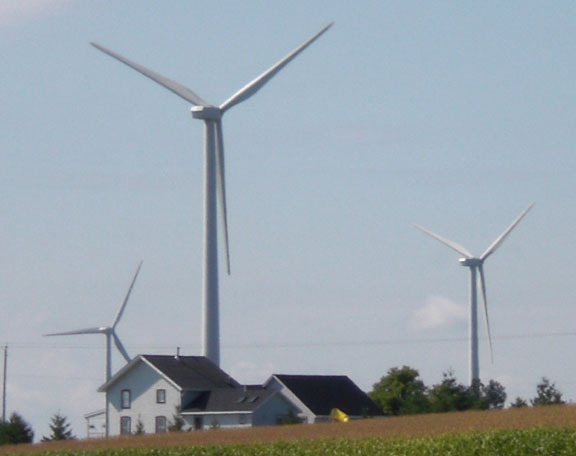 HOME IN A WISCONSIN WIND FARM: What the setbacks from homes look like in the Invenergy Forward Energy Wind Farm near the Town of Byron, Fond du Lac County
HOME IN A WISCONSIN WIND FARM: What the setbacks from homes look like in the Invenergy Forward Energy Wind Farm near the Town of Byron, Fond du Lac County
FROM THE DOCKET: If you'd like to review the testimony and public comments for the proposed Glacier Hills project CLICK HERE and enter docket number 6630-CE-302.
To see maps and find out more about this project, CLICK HERE.
The following is included as part of the documents submitted regarding the Glacier Hills project. It was written by James Vollmer, who is a resident of the Blue Sky/Green Field project which is owned by WE Energies. WE Energies will also own the Glacier Hills farm.
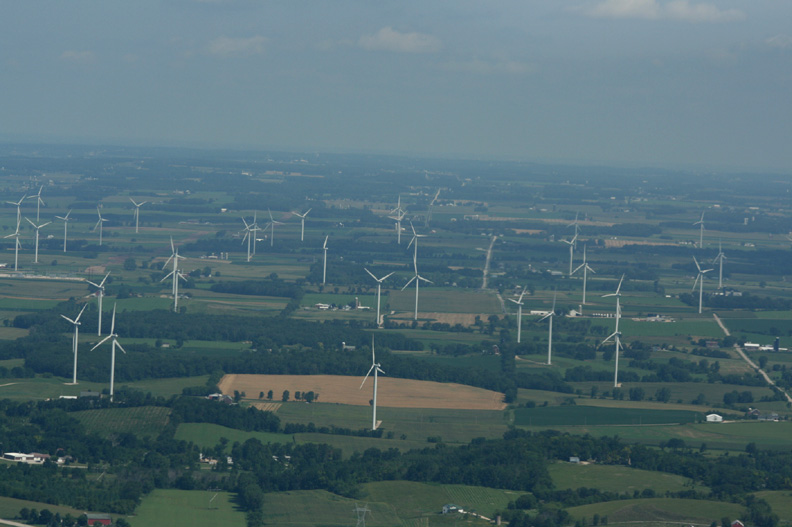 Blue Sky/ Green Field wind farm, Towns of Malone and Marshfield, Fond du Lac County. Photo by Gerry Meyer
Blue Sky/ Green Field wind farm, Towns of Malone and Marshfield, Fond du Lac County. Photo by Gerry Meyer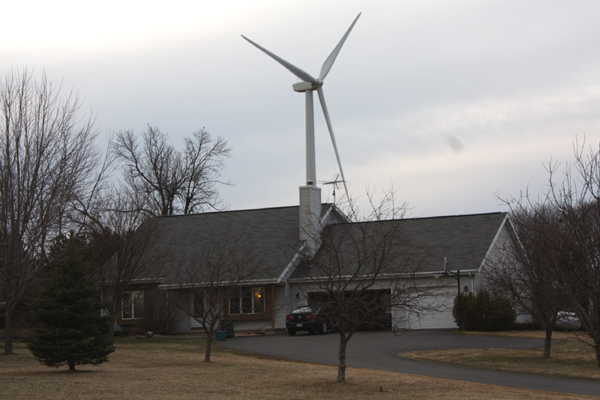 Home in a wind farm with a 1000 foot setback: Fond du Lac County Wisconsin
Home in a wind farm with a 1000 foot setback: Fond du Lac County Wisconsin
"Since the wind turbines have been turning I have had to deal with several different problems and have not had any of my complaints resolved.
I have had problems with TV reception, radio reception, cell phone phone reception, shadow flicker, poultry dying, noise keeping me awake at night and have been forced into selling my property to get away from these problems.
I'm not even able to get anyone to even make an offer on the house since it has been for sale.
When [WE Energies] started the project we were told that any TV problems would be taken care of.
Since then they have made me jump through all kinds of hoops in order to get the dish that was in stalled on the house. The dish still does not work properly. When watching the TV the screen still locks up and the voices are off from the lip movement and the only thing they tell me is that I have to wait for the technology to get better.
It is coming up on two years and the problems are still not fixed.
Now they are going around and having people sign a contract that will only give them the local channels which consist of four stations. And should we be happy with this?
I will take time and send in more info on this subject as I have time.
(Written by James Vollmer to the Public Service Commission of Wisconsin)
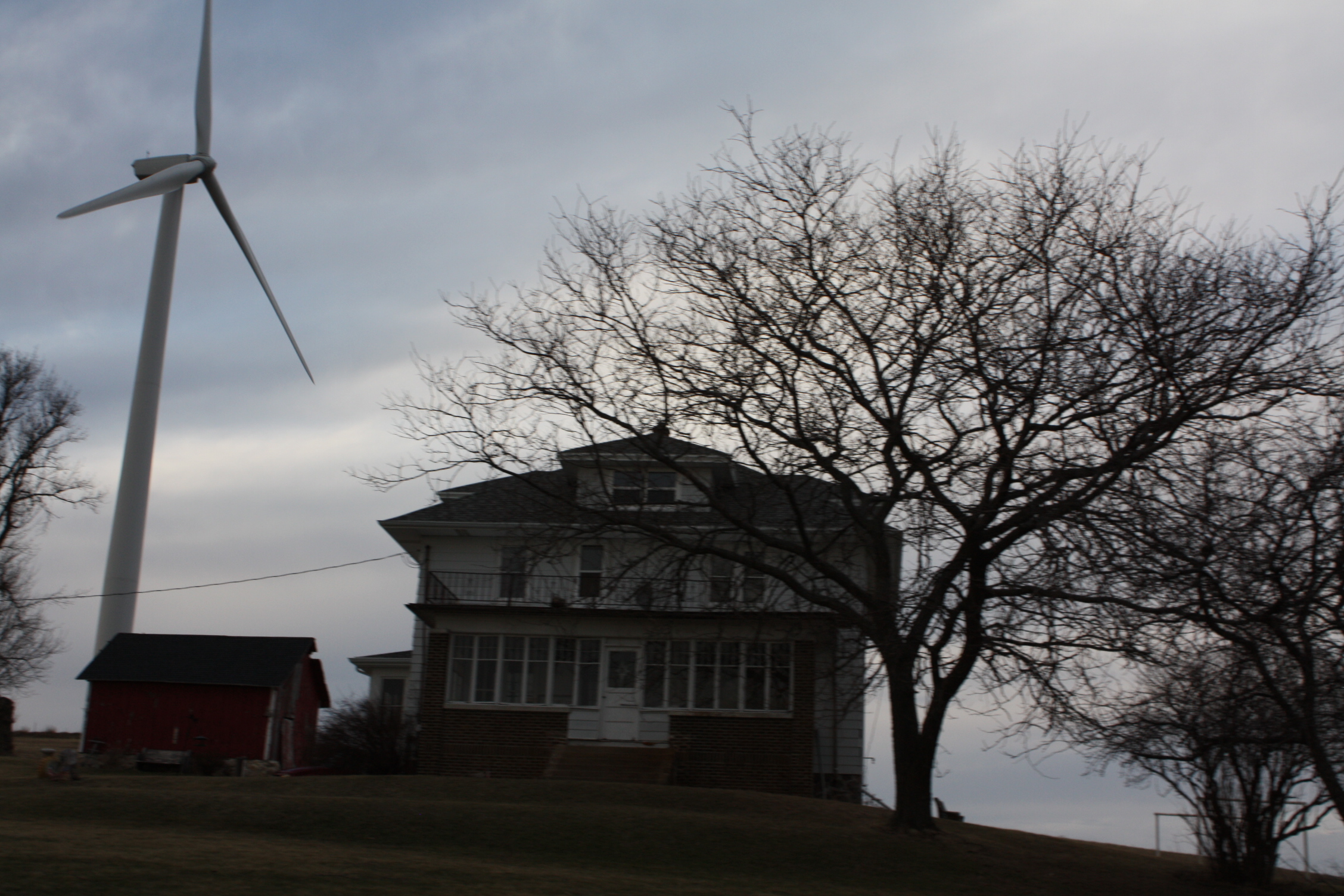
Mr. Vollmer was one of the residents interviewed for a book proposal about life in a Wisconsin Wind farm. The interview took place in late June of this year.
This is an early draft of the chapter about his experiences:
James Vollmer’s home is located inside one of Wisconsin’s more recent wind farms near the town of Malone, in Fond du Lac County. The 88- turbine project known as Blue Sky/Green Field, has been operational for about a year and a half.
The yellow farm house is an old-fashioned four-square and the vintage barn is attractive, solid and has a brand new roof.
There is a superb mechanic’s workshop large enough to contain a few vintage cars, tractors, huge pieces of farm equipment, work benches and heavy duty tools. It has a fine concrete floor.
James is a mechanic and he did most of the work on the shop himself, putting everything he had into getting it just the way he wanted it. He intended to be there awhile.
There is also a nice sized chicken house and from it comes the pleasant sound of roosters crowing and chickens clucking. James also raises poultry. He’s been breeding and showing prize-winning birds for most of his life.
It’s a tidy little farm with a nice feel to it, so the “For Sale” sign in front of this home comes as a surprise.
James lets me know the for sale sign isn’t something he ever wanted to see there, but the reason for it is clear. Scores of wind turbines surround his home—each as tall as a 40-story building. And the multitude of problems that come with them have made life unbearable. The subject of selling his place clearly pained him. We spoke just a few hours before the realtor held the first open house.
The noise from the turbines is much louder and more bothersome than he was told it would be. The shadow flicker is much more severe than he was told it would be.The turbine problems also include loss of radio, TV and cell phone reception. But the most troubling problem of all has to do with his chickens.
James has been around chickens his whole life. His grandmother and grandfather raised poultry and he says he took to it right away. “I can’t remember a time in my life when I wasn’t around chickens.” He shows me a photograph taken by his grandmother of Jim as a toddler. He’s lying on his stomach with a half a dozen baby chicks nestled together on his back looking as content as if they were in a nest.
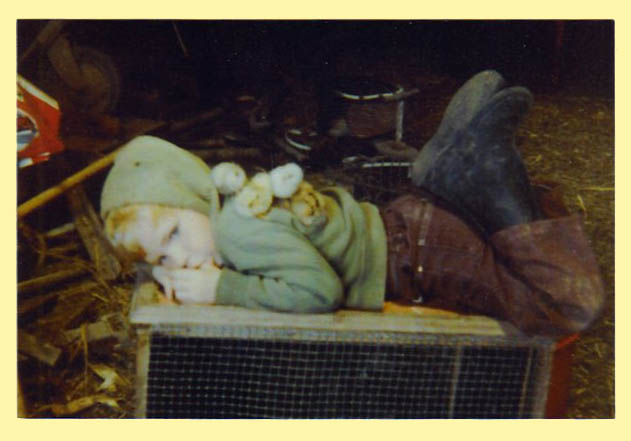
James Vollmer as a toddler with his baby chicks. Photo taken by his grandmother.
Says James, “I’ve always liked them.”
He joined 4-H and by the age of nine he was showing chickens at the county fair. He handed me one of his earliest 4-H notebooks. Even at an early age he was a meticulous record keeper, a habit he has never lost. He’s been documenting all that has happened since the wind turbines started up.
When asked about his chickens, a pained look crosses his face. How could someone who has raised healthy prize-winning poultry his whole life find himself in a situation where he is unable to keep them alive?
We go into the chicken house together. A sick bird huddles against a wire fence. A few birds move about but seem lethargic. “They shouldn’t be hanging their heads and sitting there like that,” says James, “They should be going outside and running around.”
He tells me he knew there was trouble when his birds went into a full molt the first winter the turbines were on line. “Then they pretty much quit laying eggs.” He lets me know that a full molt in winter is unusual, birds don’t molt in the winter when they need their feathers most to stay warm. And he’d never had a problem with egg production before. “I didn’t know what was going on.”
The shadow flicker from the turbines was so severe it woke him up in the morning. Like others I spoke to in the Blue Sky/Green Field project, James said the effect is unbearable. Enormous shadows passing rapidly across his entire home, barn, workshop and chicken house are relentless and inescapable. James, along with many others I spoke with, talked about getting headaches caused by the severe shadows and light flashing on and off inside and outside his house.
When he called WE Energies to complain, he was sent a form on which he was to record the time, location and duration of the shadow flicker. He did just that and sent it in.
A representative then contacted James and told him that as far as WE Energies was concerned, the shadow flicker he was experiencing was a non-issue and WE Energies had no plans to remedy the problem.
James sent along a copy of a video he’d made of the shadow flicker in his home. A representative later contacted him and offered to provide window blinds for the windows that were in the video, but would not agree to provide blinds for any of the other windows because James had not recorded them. He made yet another video, and after six months and many phone calls, WE Energies finally installed blinds on his home.
Now he has to have the blinds completely down and his lights on in the morning. He didn’t like having a dark house or having to use electricity to keep lights on during the day, but he can’t stand the shadow flicker so he had no choice.
His birds, however, were having a harder time. He tells me chickens have an instinctive fear and stress response to rapidly passing shadows. It signals the approach of predators like hawks and owls. Chickens are also very sensitive to changes in light and darkness.
James noticed the chickens didn’t seem to want to go out doors anymore after the turbines were running. Instead of behaving as they always had and getting the benefits of sunshine, fresh greens and insects, they stayed huddled in the chicken house. Their health began to suffer.
After a lifetime of successfully raising poultry, James Vollmer’s chickens were no longer thriving. Even the young birds were starting to die. When I visited with him he said he’d lost eight more in the last two weeks. “From twenty white hens, I’m down to eight or nine now.”
The chickens don’t seem to be the only birds that have been affected since the turbines went on line. James mentions the disappearance of the flocks of barn swallows that had been a fixture on the farm for years. “There used to be so many. We had twenty to thirty nests every year. when I’d cut the grass they’d just be swooping all over the place. Now they’re gone,” he says, And the hummingbirds are gone too.”
He tried everything he could think of to help his chickens but no matter what he did, the chickens continued to weaken. Then some of his chickens were taken to be raised outside of the wind plant. “The guy that took them told me chickens turned around. They got better and then they were completely fine. When they go live elsewhere they do fine.”
Though he’s certain the problems are caused by the wind turbines, he says he can’t prove anything. And even if he could, over a years worth of dealings with WE Energies has convinced him it would be useless to even try. He holds no hope of WE Energies looking into it or doing anything about it.
The frustration, worry and anger this has caused him is evident, and the stress of it all has taken its toll. “I don’t know what to do here, but I know I can’t stay.”
James Vollmer is leaving behind everything he worked so hard for, his home, the old barn he preserved and roofed, the huge mechanic’s workshop he built to last a lifetime, and the chicken house that once held so many healthy active birds.
He knows that if he can sell his place at all, he’s going to have to sell at a loss, but remaining is no longer an option for him. “I can’t be happy here anymore. I can’t even stand to be outside anymore.”
So the ‘For Sale’ sign is up, and the house he didn’t want to leave is clean and ready for the open house. He’s hoping for just the right buyer. He says it’s going have to be someone “who just doesn’t care”
Someone who doesn’t care about bad radio, TV, and cell phone reception, isn’t bothered by turbine noise loud enough to drown out the crickets at night and make you keep your windows shut all summer. Someone who doesn’t mind flashing shadows and light severe enough to wake you or force you to keep your blinds down and lights on during the day.
And most of all, it has to be someone who won’t ever miss the crowing of a rooster, the clucking of hens, the peeping of chicks, or the sweet lively song of the barn swallow.

